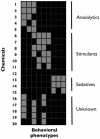Chemobehavioural phenomics and behaviour-based psychiatric drug discovery in the zebrafish
- PMID: 18784194
- PMCID: PMC2722257
- DOI: 10.1093/bfgp/eln040
Chemobehavioural phenomics and behaviour-based psychiatric drug discovery in the zebrafish
Abstract
Despite their ubiquity and impact, psychiatric illnesses and other disorders of the central nervous system remain among the most poorly treated diseases. Most psychiatric medicines were discovered due to serendipitous observations of behavioural phenotypes in humans, rodents and other mammals. Extensive behaviour-based chemical screens would likely identify novel psychiatric drugs. However, large-scale chemical screens in mammals are inefficient and impractical. In contrast, zebrafish are very well suited for high-throughput behaviour-based drug discovery. Furthermore, the vast amounts of data generated from large-scale behavioural screens in zebrafish will facilitate a systems-level analysis of how chemicals affect behaviour. Unlike serendipitous discoveries in mammals, a comprehensive and integrative analysis of zebrafish chemobehavioural phenomics may identify functional relationships that would be missed by more reductionist approaches. Thus, behaviour-based chemical screens in the zebrafish may improve our understanding of neurobiology and accelerate the pace of psychiatric drug discovery.
Figures



References
-
- Pangalos MN, Schechter LE, Hurko O. Drug development for CNS disorders: strategies for balancing risk and reducing attrition. Nat Rev Drug Discov. 2007;6:521–32. - PubMed
-
- Berton O, Nestler EJ. New approaches to antidepressant drug discovery: beyond monoamines. Nat Rev Neurosci. 2006;7:137–51. - PubMed
-
- Lansbury PTJ. Back to the future: the ‘old-fashioned’ way to new medications for neurodegeneration. Nat Med. 2004;10(Suppl):S51–7. - PubMed
-
- Sneader W. Drug Discovery: A History. Chichester: Wiley-Interscience; 2005.
-
- Michaelis M, Schölkens B, Rudolphi K. An anthology from Naunyn-Schmiedeberg's archives of pharmacology. Naunyn-Schmiedeberg's Arch Pharmacol. 2007;375:81–4. - PubMed
Publication types
MeSH terms
Substances
Grants and funding
LinkOut - more resources
Full Text Sources
Other Literature Sources
